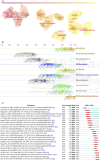Focus on podocytes: diabetic kidney disease and renal fibrosis - a global bibliometric analysis (2000-2024)
- PMID: 39619610
- PMCID: PMC11605685
- DOI: 10.3389/fphar.2024.1454586
Focus on podocytes: diabetic kidney disease and renal fibrosis - a global bibliometric analysis (2000-2024)
Abstract
Background: Diabetic kidney disease (DKD) is a common pathway to End-stage renal disease (ESRD). Podocytes are crucial due to their dual barrier functions in kidney diseases. Their role in renal fibrosis and DKD regulatory mechanisms is increasingly studied. However, bibliometric research in this field has not been explored.
Methods: 1,250 publications from Jan. 1, 2000, to Feb. 16, 2024, were retrieved from the WoSCC database and analyzed by the Web of Science results analysis tool, VOSviewer, and CiteSpace.
Results: Our scrutiny reveals that authors Liu Youhua, Fogo Agnes B, and Zhao Yingyong have made substantial contributions to this domain. Notably, "Kidney International" has the highest volume of publications in this area. Furthermore, our analysis identifies ten co-citation clusters: DKD, IncRNA, reactive oxygen species, glomerulosclerosis, Poria cocos, glomerular diseases, fibroblasts, connective tissue growth factor, coagulation, and Wnt. Recent research accentuates keywords such as autophagy, TRPC6, ERS, epigenetics, and NLRP3 inflammasome as frequently occurring terms in this field. The prevailing research hotspot keywords include autophagy, biomarker, and exosomes.
Conclusion: Through the utilization of bibliometric tools and knowledge graph analysis, we have undertaken a comprehensive review of the intricate nexus between podocytes in DKD and renal fibrosis. This study imparts valuable insights to scholars regarding the dynamic evolution of this association and delineates prospective research avenues in this pivotal realm.
Keywords: DKD; Poria cocos; holistic integrated medicine; podocytes; renal fibrosis.
Copyright © 2024 An, Tan, Lu, Wen, Bao, Yao, Chen, Wang, Zhou, Yang and Hao.
Conflict of interest statement
The authors declare that the research was conducted in the absence of any commercial or financial relationships that could be construed as a potential conflict of interest.
Figures





Similar articles
-
Bibliometric Analysis of Renal Fibrosis in Diabetic Kidney Disease From 1985 to 2020.Front Public Health. 2022 Feb 4;10:767591. doi: 10.3389/fpubh.2022.767591. eCollection 2022. Front Public Health. 2022. PMID: 35186833 Free PMC article.
-
The intellectual base and global trends in inflammation of diabetic kidney disease: a bibliometric analysis.Ren Fail. 2023;45(2):2270061. doi: 10.1080/0886022X.2023.2270061. Epub 2023 Oct 23. Ren Fail. 2023. PMID: 37870857 Free PMC article. Review.
-
Global diabetic kidney disease research from 2000 to 2017: A bibliometric analysis.Medicine (Baltimore). 2019 Feb;98(6):e14394. doi: 10.1097/MD.0000000000014394. Medicine (Baltimore). 2019. PMID: 30732183 Free PMC article.
-
Research hotspots and future trends in lipid metabolism in chronic kidney disease: a bibliometric and visualization analysis from 2004 to 2023.Front Pharmacol. 2024 Sep 3;15:1401939. doi: 10.3389/fphar.2024.1401939. eCollection 2024. Front Pharmacol. 2024. PMID: 39290864 Free PMC article.
-
Macrophage inflammatory protein-1β as a novel therapeutic target for renal protection in diabetic kidney disease.Biomed Pharmacother. 2023 May;161:114450. doi: 10.1016/j.biopha.2023.114450. Epub 2023 Feb 28. Biomed Pharmacother. 2023. PMID: 36863097
Cited by
-
Shenyuan granules improve cellular senescence through Klotho-mediated p16/p21 signaling pathway in diabetic kidney disease.Front Med (Lausanne). 2025 Jul 31;12:1627412. doi: 10.3389/fmed.2025.1627412. eCollection 2025. Front Med (Lausanne). 2025. PMID: 40823556 Free PMC article.
References
-
- Bai X. Y., Geng J., Li X., Wan J., Liu J. X., Zhou Z. M., et al. (2018). Long noncoding RNA LINC01619 regulates MicroRNA-27a/forkhead box protein O1 and endoplasmic reticulum stress-mediated podocyte injury in diabetic nephropathy. Antioxidants and Redox Signal. 29 (4), 355–376. 10.1089/ars.2017.7278 - DOI - PubMed
Publication types
LinkOut - more resources
Full Text Sources

